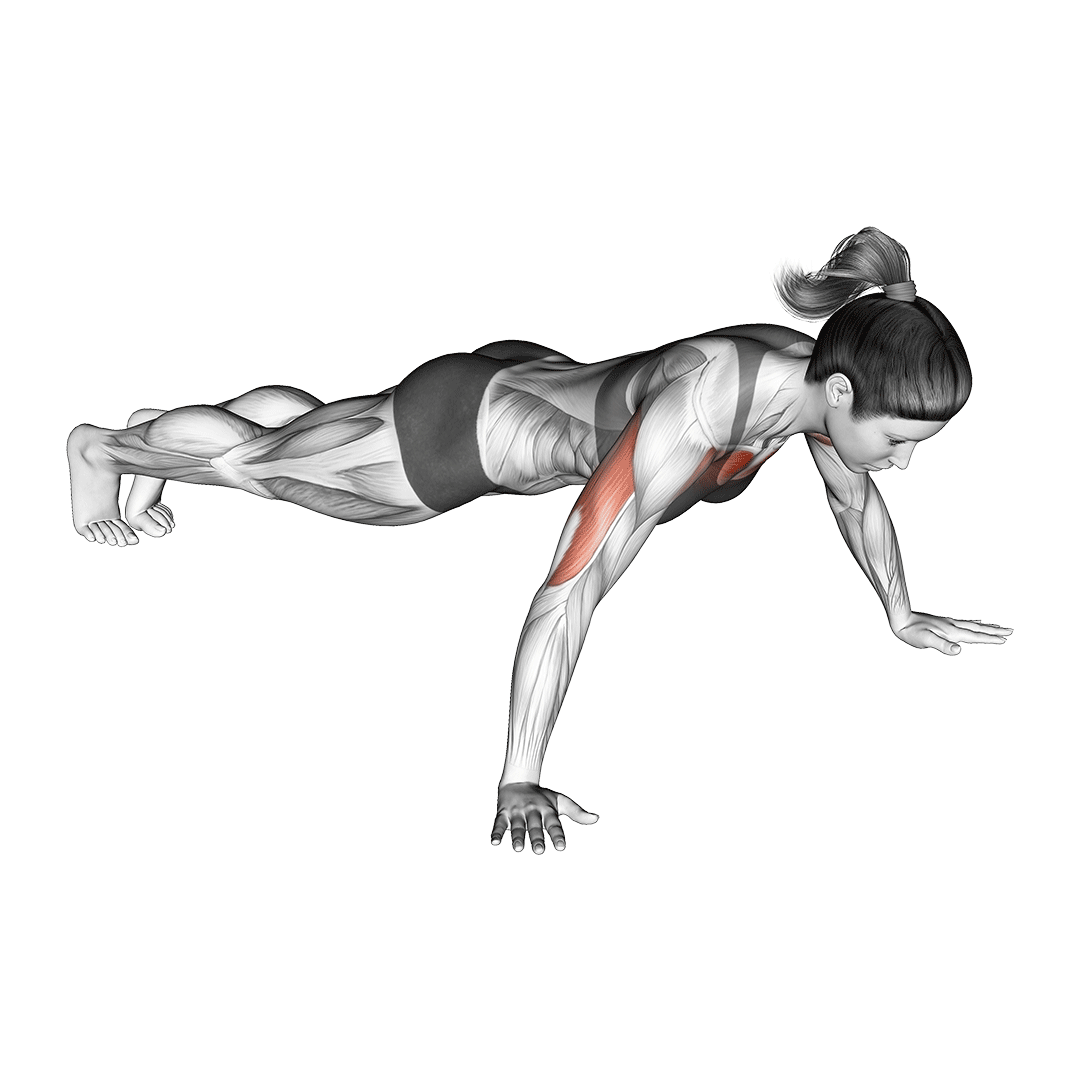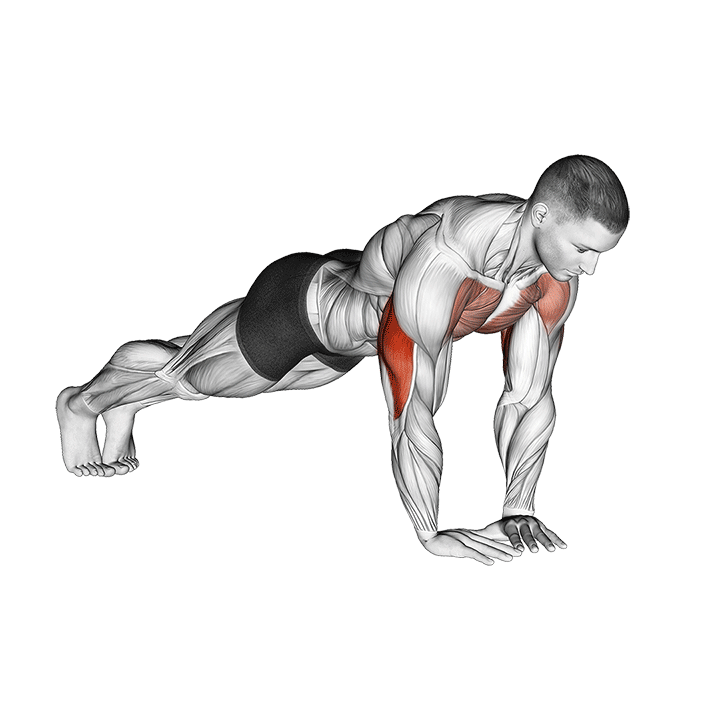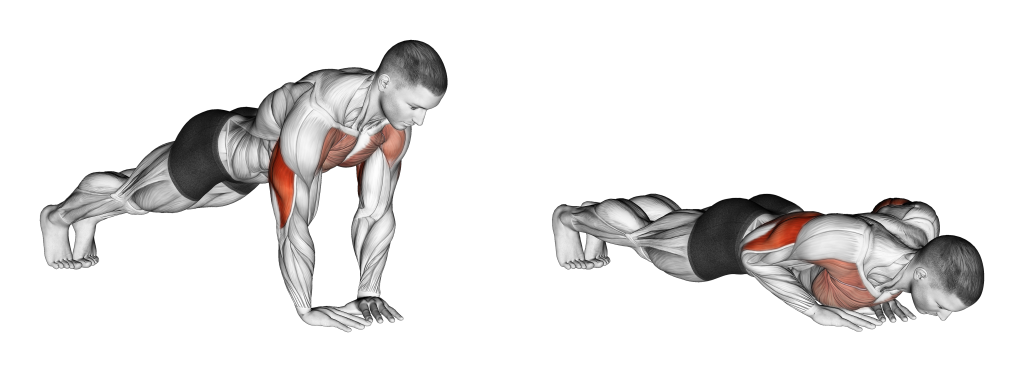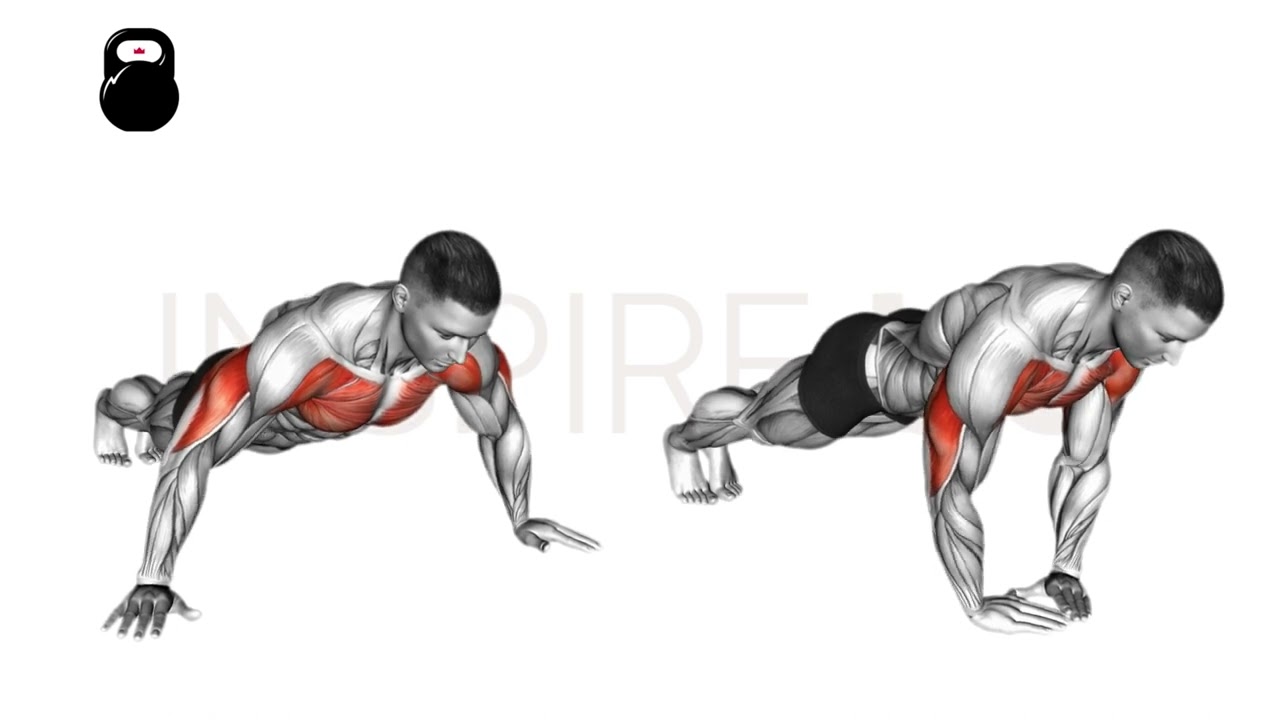Wide vs Narrow Push-Ups: Differences Explained
As popular as the classic push-up is, there are actually quite a number of different variations available to the modern lifter - some of which feature radically different form or distinct changes in the primary mechanics of a push-up.
Two of these variations are the wide grip and narrow grip push-up, of which simply set the hands at different distances so as to alter the focus of the exercise.
To put it short, the wide grip push-up features greater pectoral muscle recruitment, whereas the narrow grip push-up will target the muscles of the triceps to a higher level.
What are Wide Push-Ups?
Wide push-ups or wide grip push-ups are a multi-joint compound exercise primarily performed for the purposes of training the chest with a high amount of volume per set.

Much like conventional push-ups, wide push-ups are traditionally performed with the exerciser’s own weight as the sole source of resistance, and will require no equipment whatsoever.
Muscles Worked by Wide Push-ups
Wide push-ups train the triceps brachii, the anterior head of the deltoids, the core, the serratus and the pectoral muscles.
How to do Wide Push-Ups
To perform a repetition of wide push-ups, the exerciser will set their hands considerably wider than shoulder-width apart, keeping their body in a plank position as they do so.

Bending at the elbows, the exerciser will then lower themselves to within several inches of the ground, before pushing through the palms and rising back to the starting plank position.
What are Narrow Push-Ups?
Narrow or close grip push-ups are also a multi-joint compound exercise involving body weight resistance, though they are primarily performed to target the muscles of the arms with high volume, rather than the chest.

Just as is the case with ordinary push-ups, narrow push-ups do not normally require equipment, and are used either as an accessory to weighted compound exercises or as the primary compound movement in a triceps-focused workout.
Muscles Worked by Narrow Push-ups
Narrow push-ups will recruit the muscles of the pectorals, the anterior deltoid head, the core, the serratus and the triceps brachii.
How to do Narrow Push-Ups
Setting the hands close to the sides of the torso, the exerciser will assume the standard plank stance with their core contracted and the back relatively flat.

Bending the elbows towards the back (rather than to the sides), the exerciser will then lower themselves towards the ground, stopping once the chest is within several inches of touching the floor.
To complete the repetition, the exerciser will then push through their palms and extend their elbows, stopping once they have returned to their original position.
Muscular Focus of Wide and Narrow Push-Ups
Though changing the distance between the hands seems like a relatively small alteration, the wide and narrow push-up actually differ quite significantly in terms of what muscles are emphasized by either movement.
Setting the hands further apart puts the triceps brachii in a disadvantageous position, forcing the muscles of the pectorals to bear more weight.
The opposite is just as true by bringing the hands closer than shoulder-width apart, which will reduce the involvement of the chest muscles and instead place the triceps in a far more advantageous position.
Which Push-Up is Best for Which Muscle?
Choosing between the two push-up variations is simple; if a greater focus on the arms is needed, then the narrow push-up is a better choice.
If the chest and deltoids require more training, the wide push-up is the right path.
Difficulty and Complexity of Wide and Narrow Push-Ups
Though both the wide and narrow push-up are relatively simple to perform, it is the narrow variation that is considered to be somewhat more difficult, even if it is only because the muscles are challenged to a greater extent.
While deciding between the two is somewhat more nuanced than simply which one works the muscles harder, it is also true that narrow push-ups require greater control over the elbows, the capacity to properly recruit the pectoral muscles in a conscious manner and triceps that are already developed enough to bear the weight of the body.
In comparison to conventional push-ups, both wide and narrow push-ups are considerably more complex, and will require greater strength in their own individual ways.
Which Push-Up is Better for Novices?
If progressing from conventional push-ups, it is better to do wide grip push-ups, as the wide variation involves less technical skill and will be less likely to result in injury if performed with improper form.
As a side note, complete beginners who are unfamiliar with push-ups should start with regular push-ups, rather than wide or narrow push-ups, as both will require greater upper body strength and exercise familiarity to perform.
If you are incapable of performing a regular push-up, consider knee push ups.
Impact and Injury Risk of Wide and Narrow Push-Ups
As exercises become more intense and technically complex, the risk of injury will also increase - even for movements as comparatively low-impact as the push-up.
This is especially true for the wide grip and narrow grip push-up, both of which are somewhat more likely to result in injury than a regular push-up when performed with incorrect form.
In particular however, it is the narrow push-up that is more likely to result in irritation and injury. This takes the form of elbow tendonitis or similar soft-tissue injuries, and is usually a sign of the exerciser performing the movement with flared elbows, or to an excess amount of volume.
So - for exercisers who are particularly worried about injury? It is better to pick the wide push-up, rather than the narrow one.
Form Tips to Avoid Injury from Wide and Narrow Push-Ups
It goes without saying that both push-up variations are safe when performed with correct form, but there are several further aspects that may be focused on to further reduce any risk of an injury occurring.
The first and most important is to perform each repetition in a slow and controlled manner, with careful attention paid to maintaining a rigid torso throughout the entire range of motion. This will ensure that no part of the body is forced to compensate for an unstable torso, and that the muscles of the triceps, shoulders and chest are supported properly.
Furthermore, performing a mobility drill and warm-up routine prior to beginning push-ups will ensure that the body is prepared for intense exercise, and will help prevent acute injury if any break in proper form is present.
Finally, any flaring of the elbow or shoulder blades must be avoided, regardless of what push-up variation is being performed. Allowing the elbows to drift outwards can easily result in an excessive amount of pressure being placed on the soft tissues of the joint.
Wide or Narrow Push-Ups for Explosiveness and Power
The push-up is considered a classic among athletic training programs for its capacity to build upper-body explosiveness and power. When programming for the same sort of stimulus, it is in fact the wide push-up that is superior in this particular aspect, rather than the narrow variation.
The wide grip push-up produces greater explosiveness and power because of a significant focus on the anterior deltoid head and pectorals, both of which are larger than the triceps and play a greater role in producing upper body force.
Furthermore, the wider stance involved in the exercise will necessitate a greater amount of tension across the entire upper body, helping develop the potential for power in muscles like the serratus and deltoids.
Wide or Narrow Push-Ups for Mass and Strength
Though it is true that wide push-ups are better for developing the more athletically-oriented side of muscular training, it is in fact the narrow push-up that is superior for gross strength and muscle mass.
Not only do EMG studies indicate a greater activation of the triceps with a narrow stance push-up, but the positioning of the arms will allow the exerciser to better leverage their own body’s weight against the muscles of the upper body, resulting in more efficient repetitions that can lead to greater hypertrophy.
And while it is indeed true that wide grip push-ups better target the pectoral muscles, this is due to an absence of triceps recruitment, rather than pure intensity of activation - something that is not so much the case with the narrow push-up, which could induce hypertrophy in the pectorals to a similar extent.
Can Wide and Narrow Push-Ups be Performed Together?
Unlike most other push-up variations, the wide and narrow push-up complement each other quite well when performed within the same workout.
This is due to the manner in which they focus on different muscle groups, with the wide push-up’s reduced involvement of the triceps being made up for by the narrow push-up.
Nonetheless, even with a different emphasis between the two variations, they will still fatigue the “push” muscles of the upper body unless programmed correctly.
How to Program Wide Push-Ups and Narrow Push-Ups Together
In order to combine both wide and narrow push-ups within the same workout, the narrow push-up’s greater intensity should be accounted for by placing it first within the order of exercises.
Keeping the volume of each set low, the wide push-up may further act as a secondary compound exercise to help round out the training stimulus of the upper body, allowing for a more uniform distribution of volume across the pectorals, triceps and deltoids.
A good starting point would be 2-3 sets of 8-15 repetitions of narrow push-ups, followed by 2-3 sets of 10-20 repetitions of wide push-ups, adjusting volume as needed.
Frequently Asked Questions (FAQ)
Are Narrow Push-Ups Harder Than Wide?
Yes - narrow push-ups are considered to be more difficult to perform than wide push-ups due to the greater stress placed on the muscles of the upper body.
While the wide push-up is less advantageous in terms of triceps activation, it still requires less muscular strength than the narrow push-up would utilize in totality, meaning that the athlete will need to already be strong to effectively perform narrow push-ups.
Are Wide Push-Ups "Better"?
In certain aspects, yes - wide push-ups may be better than other push-up variations.
In particular, the muscles of the pectorals and serratus anterior see far greater recruitment from push-ups performed with a wider hand placement than would be seen with push-ups of a standard stance.
With regular performance and proper recovery, wide push-ups will not only build a bigger and more defined chest, but also help reinforce movement of the arms and torso.
What’s the Best Push-Up for Your Chest?
Because of the sheer number of push-up variations available, nailing down the perfect push-up for your chest is quite difficult, and can vary between individual needs and experience levels.
However, a good place to start is to look for push-ups that involve a wider than shoulder width stance. Push-ups involving such a stance will generally have a reduced level of triceps recruitment, of which translates to the chest muscles being worked to a greater degree to compensate.
A few good examples of this are the wide push-up, the deficit push-up and the archer push-up.
In Conclusion, Which Push-Up is Better?
So - when deciding between the wide and narrow push-up, the most appropriate choice should be based on the experience level of the athlete, as well as their specific training goals.
Newer exercisers that wish to place a greater focus on their chest and serratus will find better and safer training with the wide push-up - whereas more advanced exercisers who are seeking hypertrophy and strength developments across the entire upper body should perform narrow push-ups instead.
Keep in mind that your choice of exercise is not solely constrained to just wide or narrow push-ups, and that if neither are an appropriate choice for your workout, it is possible to pick a different exercise entirely.
References
1. Kim YS, Kim DY, Ha MS. Effect of the push-up exercise at different palmar width on muscle activities. J Phys Ther Sci. 2016 Jan;28(2):446-9. doi: 10.1589/jpts.28.446. Epub 2016 Feb 29. PMID: 27064571; PMCID: PMC4792988.
2. COGLEY, ROBERT M.; ARCHAMBAULT, TEASHA A.; FIBEGER, JON F.; KOVERMAN, MANDY M.; YOUDAS, JAMES W.; HOLLMAN, JOHN H.. COMPARISON OF MUSCLE ACTIVATION USING VARIOUS HAND POSITIONS DURING THE PUSH-UP EXERCISE. Journal of Strength and Conditioning Research 19(3):p 628-633, August 2005.

